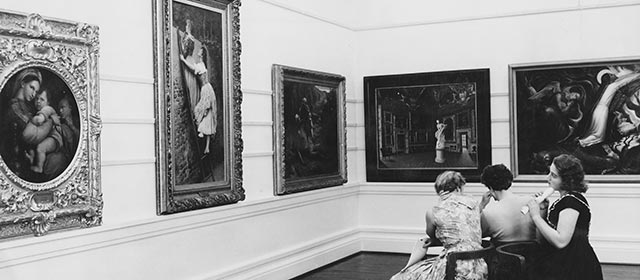He korero whakarapopoto
19th-century collections and galleries
The first collections of European art arrived with settlers in the 19th century. Personal art collections were sometimes displayed at public exhibitions.
Art societies formed around the country from 1869. They held exhibitions and started their own art collections.
In the 1880s the first public art galleries were founded. Some, such as the Dunedin Public Art Gallery, gained their collections from art societies. Others benefitted from donations from individual art collectors. Former Governor George Grey gave his collection to the Auckland Art Gallery.
1900 to 1960s
In the early 20th century new galleries were founded, including the Sarjeant Gallery in Whanganui and the Robert McDougall Art Gallery in Christchurch, which were both named after the people who funded them.
The National Art Gallery was established in Wellington in 1936. Its collection, which it inherited from the New Zealand Academy of Fine Arts, was dominated by British art.
In 1940, to mark New Zealand’s centennial, an exhibition of New Zealand art toured the country. It included contemporary paintings and even cartoons.
More art galleries opened after the Second World War in provincial towns and cities, including Hamilton, Invercargill and Gisborne. They were generally run by volunteers and councils, and tended to be conservative in their art choices. Some artists, particularly modernists, formed their own groups to exhibit their own work.
Dealer galleries, which sell art, became more important from the 1960s and encouraged the buying of New Zealand art by private or corporate collectors.
1970s to 2000s
New Zealanders had a growing sense of the country as a Pacific nation, rather than a British outpost, and this increased interest in contemporary New Zealand art.
New public galleries opened around New Zealand in the 1970s and 1980s. They included some, such as the Govett-Brewster in New Plymouth, that focused on contemporary art. City Gallery Wellington, which opened in 1980, is unusual in that it does not have its own art collection. Galleries were increasingly run by professional staff, who had less conservative ideas about art.
In 1992 New Zealand’s National Art Gallery was merged with the National Museum to form the Museum of New Zealand Te Papa Tongarewa. When the museum moved to a new building in 1998 there was considerable criticism of the limited space for art and the way it was displayed.





